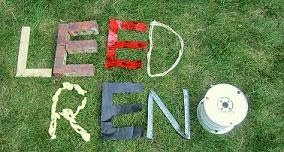I'll probably get into more detail on air leaks in another post, but for now lets just say that they are bad. One of the best ways to improve the efficiency of your home is to stop all your warm air from sneaking out. One highly recommended way of doing that is to fill all the voids between your windows and their frames.
So when all the kitchen walls were exposed, I grabbed a can of "Great Stuff - Window and Door" and started sealing. "Great Stuff" is an all purpose expanding polyurethane foam. It expands to fill the void and creates an airtight seal, insulating layer and repels water. The window and door version keeps the expansion in check so that it doesn't cause warping or cracking of your window.
I happily filled the cracks, emptying the whole can and then trimmed off the overfill. It was at this point that I took stock of the mess and waste I had generated
Keep in mind, we just finished our deconstruction efforts where we trying to ensure we created no garbage. So when I saw that one window's worth of insulation had generated a small pile of un-recyclable trimming and an empty aerosol can, I was disappointed.I think what bugged me the most wasn't just the garbage, it was the fact that I had no idea how green the product was or if there were better alternatives.
I decided to do some after-the-fact investigation (I do have 12 more windows to seal) on the Internet. Below was what I managed to scrounge up for some environmental pros and cons of Dow's "Great Stuff":
Cons:
- throw away packaging
- non-renewable product
- material is non-biodegradable and not easily recyclable
- may discharge VOCs during application but doesn't appear to off gas continually.
- potentially toxic to aquatic life
Pros:
- no CFCs (non-ozone depleting, but I didn't think much was these days)
- no solvents
- contains no nuclear waste
- it works
The biggest advantage seems to be that last one. In an older house up to 17% of your heating bill is for energy lost through gaps around windows and doors. When I started looking into alternatives there didn't seem to be much that matched Great Stuff in effectiveness. The old school method was to jam fibreglass insulation in there which may slow a draft but isn't air tight and offers no insulation.
Modern alternatives tended to be non-expanding so they wouldn't provide a tight air seal or urethane or latex based which aren't as effective at controlling moisture. One alternative with a green twist was "Touch n Foam Max Fill", a "renewable resource" based expanding foam. Unfortunately though, the green version is not available in a "door and window" version.
So in the short term I am going to view it as a necessary evil. I will though convert to the Great Stuff pro series with the applicator gun. Bigger cans with control over the bead size should mean that I will have less overfill and generate a less waste from the aerosol cans.
But in the meant time I will keep searcher for something better. If anyone out there has found a greener solution, please let me know!

.JPG)






